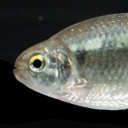The Mexican tetra or blind cave fish (Astyanax mexicanus) is a freshwater fish of the family Characidae of the order Characiformes. The type species of its genus, it is native to the Nearctic ecozone, originating in the lower Rio Grande and the Neueces and Pecos Rivers in Texas, as well as the central and eastern parts of Mexico.
The eyed and eyeless forms of A. mexicanus, being members of the same species, are closely related and can interbreed making this species an excellent model organism for examining convergent and parallel evolution, regressive evolution in cave animals, and the genetic basis of regressive traits. This, combined with the ease of maintaining the species in captivity, has made it the most studied cavefish and likely also the most studied cave organism overall.
Assembly
The Astyanax_mexicanus-2.0 assembly was submitted by Washington University School of Medince on September 2017. The assembly is on chromosome level, consisting of 3,030 contigs assembled into 2,415 scaffolds. From these sequences, 25 chromosomes have been built. The N50 size is the length such that 50% of the assembled genome lies in blocks of the N50 size or longer. The N50 length for the contigs is 1,767,240 while the scaffold N50 is 35,377,769.
Other assemblies
- AstMex102 (Ensembl release 80)
Gene annotation
The gene annotation process was carried out using a combination of protein-to-genome alignments, annotation mapping from a suitable reference species and RNA-seq alignments (where RNA-seq data with appropriate meta data were publicly available). For each candidate gene region, a selection process was applied to choose the most appropriate set of transcripts based on evolutionary distance, experimental evidence for the source data and quality of the alignments.Small ncRNAs were obtained using a combination of BLAST and Infernal/RNAfold. Pseudogenes were calculated by looking at genes with a large percentage of non-biological introns (introns of <10bp), where the gene was covered in repeats, or where the gene was single exon and evidence of a functional multi-exon paralog was found elsewhere in the genome. lincRNAs were generated via RNA-seq data where no evidence of protein homology or protein domains could be found in the transcript.
In accordance with the Fort Lauderdale Agreement, please check the publication status of the genome/assembly before publishing any genome-wide analyses using these data.
More information
General information about this species can be found in Wikipedia.
Statistics
Summary
| Assembly | Astyanax_mexicanus-2.0, INSDC Assembly GCA_000372685.2, Sep 2017 |
| Base Pairs | 1,335,239,194 |
| Golden Path Length | 1,335,239,194 |
| Annotation provider | Ensembl |
| Annotation method | Full genebuild |
| Genebuild started | May 2018 |
| Genebuild released | Jul 2018 |
| Genebuild last updated/patched | Mar 2020 |
| Database version | 111.2 |
Gene counts
| Coding genes | 26,698 |
| Non coding genes | 680 |
| Small non coding genes | 652 |
| Long non coding genes | 7 |
| Misc non coding genes | 21 |
| Pseudogenes | 42 |
| Gene transcripts | 41,410 |
Other
| Genscan gene predictions | 59,833 |
